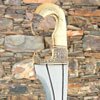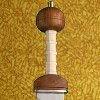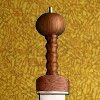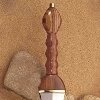|
|
|
 |
|
| Spiculus Gladius Windlass (501782) |
Points: 10


|
We've designed this gladius to be true to the period, yet worthy of a champion (of course, a plain gladius was the sword carried by all rank-and-file legionnaires). The high-carbon steel blade is extra-long – 24 inches – for extended reach in the critical moments of mortal combat. Despite its added length, this sword still weighs under 2 lbs and feels light and exceptionally lively in the hand.
|
|
|
|
|
|
 |
|
| Windlass Steelcraft Falcata |
Points: 12

|
Circa 200 BC
The Celt-Iberians of Roman times were justly famed for their weapons, such as the Falcata; one of the most devastating swords ever made! The inward curving blade delivered a tremendous blow and could split both shield and helmet. Considered to be of Greek, or possibly Etruscan origin, this sword spread into Southern Russia and also Spain. It was in Spanish hands that it was most feared by the Romans. The blade is made from high carbon steel. The handle is solid brass. Comes with brown leather scabbard.
500062 - not sharp
500062s - sharpened
|
|
|
|
|
|
 |
|
| Gladius - Maintz Pattern |
Points: 15

|
2.The Roman Army’s approach to warfare was direct and pragmatic. It chose the Gladius as its principal sidearm because it was practical and efficient and excelled in any close combat situation. The early Gladius (our version is the Maintz pattern) was wasp waisted with a long point that combined cutting power and stabbing ability in one handy weapon. This is the sword that conquered most of the known world. Made of high carbon steel by Windlass Steelcrafts®. Originals were excavated from the ruins of Pompeii. You can see examples in H. Russell Robinson’s book "What The Soldiers Wore On Hadrian’s Wall'". This gladius in the maintz pattern has a faux ivory grip with ornate brass applique on the scabbard.
Similar to Maksimus Decimus Meridus sword used in Gladiator movie.
500360 - not sharp
500360s - sharpened
|
|
|
|
|
|
 |
|
| Gladius - The Pompeii |
Points: 10

|
Circa 100 BC
The Roman Army's approach to warfare was direct and pragmatic. It chose the Gladius as its principal sidearm because it was practical, efficient and excelled in any close combat situation. The later version (we offer you the Pompeii) were not waisted and had a shorter point but were just as effective and easier to make. Turned ash and maple handle. 2" wide. This is the sword that conquered most of the known world. High carbon steel. Made by Windlass Steelcrafts®. Originals were excavated from the ruins of Pompeii. You can see examples in H. Russell Robinson's book "What The Soldiers Wore On Hadrian's Wall".
500598 - not sharp
500598s - sharpened
|
|
|
|
|
|
 |
|
| Roman Pugio Dagger (401392) |
Points: 9

|
Circa 100
The distinct shape of the Pugio blade was excellent for a close quarters fight, and was used throughout the legions. Although swords and knives were generally not worn by civilians within the boundaries of the "Pax Romana", barbarians and bandits were certainly to be found in the outlands, and a merchant or trader best go armed. No doubt many an old legionnaire must have found it easier to keep his balance with the familiar weight on his hip as he worked his farm in new won territory. The wood hilt is paired with a fully tempered high carbon steel blade. Comes complete with a wood scabbard covered in leather with brass parts. Based on remains in the British Museum. Made by Windlass Steelcrafts.
|
|
|
|
|
|
|
|
Tags:
ancient swords, Falcata, Kopis, greek sword, persian sword, roman sword, gladius,
|







